Beneficial Insects: Who’s Sleeping in Your Daisies?
By: Pam WolfeThe Integrated Pest Information Platform for Extension and Education (iPiPE) provides an infrastructure with cyber-age tools, information products, and expert commentary for the detection and management of pests that threaten U.S. crops. By categorizing pests, data, and users, it enables sharing observations while protecting the privacy of individuals, companies, and government agencies.The program also monitors beneficial insects. In 2018 Dr. Ashley Bennett, extension IPM specialist at NMSU, was awarded funding for a project to develop baseline counts. Dr. Bennett met with volunteers in April to describe the sampling plan and teach basic identification skills for our foray into the observation and counting of bees, wasps, syrphid flies, lady beetles, lacewings, and minute pirate bugs. Twice monthly from June through August data were gathered in a total of 52 parks, gardens, natural areas, urban farms, and backyards in Los Alamos, Santa Fe, and Las Cruces.Data collected by volunteers across the country will be available online through the iPiPE portal as soon as it is entered into the system. The data collected this summer in New Mexico will set a baseline for ongoing monitoring of population density and diversity. Dr. Bennett will continue this project next summer, so data collected this year will be compared to that collected in 2019. Dr. Bennett, along with the two undergraduate interns who assisted with sampling in 2018, will present their results at a conference in the spring of 2019 at North Carolina State University.The behaviors of the predators and parasitoids makes it abundantly clear why the most important steps in Integrated Pest Management are cultural practice and biological control. While predators eat their prey directly, the parasitoids lay eggs in the eggs or on (or in) the bodies of their host. They are efficient at finding hosts and work from early spring into the fall. In many cases it’s the larva that prey on pests; a hoverfly (family Syrphidae) scouted for aphids on the underside of the leaves of Nepeta yunnanensisbefore laying an egg. This egg will hatch into a small colony of aphids, lunch!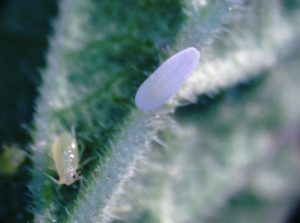
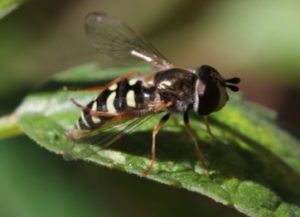 For some of us, spending quality time with the six-legged visitors to our yards and gardens was a first. It takes some practice (and patience) to learn to distinguish certain wasps and hoverflies from the bees they have evolved to resemble. The minute pirate bug (family Anthocoridae) is so small (1.5–5 mm) one might overlook the animal if not intent on finding one. Among my personal favorites, although not among the insects we counted, is the two-spotted collops beetle (Collops bipunctata). Lady beetles were in short supply in my garden this summer, but this little predator was not.
For some of us, spending quality time with the six-legged visitors to our yards and gardens was a first. It takes some practice (and patience) to learn to distinguish certain wasps and hoverflies from the bees they have evolved to resemble. The minute pirate bug (family Anthocoridae) is so small (1.5–5 mm) one might overlook the animal if not intent on finding one. Among my personal favorites, although not among the insects we counted, is the two-spotted collops beetle (Collops bipunctata). Lady beetles were in short supply in my garden this summer, but this little predator was not.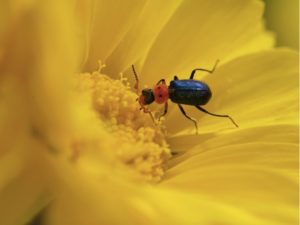 The range in size and number of species within families of bees is surprising. The family Apidae, for example, contains more than 5,700 species in more than 200 genera worldwide [1]. This is the family of the familiar European honey bee (Apis mellifera) and bumble bees (Bombusspp), but it also includes long-horned bees, digger bees, and squash bees [2]. In my garden one small sweat bee (family Halictidae) foraged in poppy mallow (Callihroe involucrata) blossoms. Megachilids foraged in cactus blossoms in June and switched to the composites thereafter. Long-horned bees (families Eucera and Melissodes) slept in desert marigold (Baileya multiradiata), cowpen daisy (Verbesina encelioides), and squash blossoms (family Cucurbitae).
The range in size and number of species within families of bees is surprising. The family Apidae, for example, contains more than 5,700 species in more than 200 genera worldwide [1]. This is the family of the familiar European honey bee (Apis mellifera) and bumble bees (Bombusspp), but it also includes long-horned bees, digger bees, and squash bees [2]. In my garden one small sweat bee (family Halictidae) foraged in poppy mallow (Callihroe involucrata) blossoms. Megachilids foraged in cactus blossoms in June and switched to the composites thereafter. Long-horned bees (families Eucera and Melissodes) slept in desert marigold (Baileya multiradiata), cowpen daisy (Verbesina encelioides), and squash blossoms (family Cucurbitae).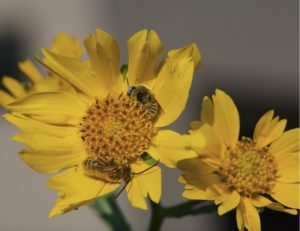 One morning I noticed an odd shape in the foliage of the cowpen daisy; blending in perfectly was the generalist predator Mantis religiosa. I watched for nearly half an hour while the bees continued foraging; none came within her reach
One morning I noticed an odd shape in the foliage of the cowpen daisy; blending in perfectly was the generalist predator Mantis religiosa. I watched for nearly half an hour while the bees continued foraging; none came within her reach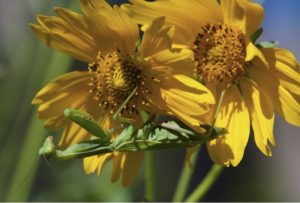 Beneficial insects require habitat, food, and in some cases water. To attract pollinators, offer a diverse selection of native flowering plants with a range of bloom times, from early spring through fall, and a variety of colors, scents, and flower shapes. See the July 2016issue of the SFMGA Newsletter, as well as the Pocket Guide to the Native Bees of New Mexico(NMSU and NRCS), for details on attracting native bees to your garden. To gain an even broader range of beneficial insects, consider the addition of a “beetle bank” [3]. Although the concept was developed in an agricultural context (where large swaths of monocrops meant the loss of habitat for beneficial insects and thus their services in pest control), it can readily be applied to a long stretch running between driveways or the far reaches of a yard, where very low maintenance is appealing. A planting of tussock-forming native grasses will attract over-wintering predatory invertebrates that will migrate back into the garden in spring.Bees sleeping in flowers, hoverflies ovipositing, mantids waiting. Such much entertainment. So close to home.Notes:
Beneficial insects require habitat, food, and in some cases water. To attract pollinators, offer a diverse selection of native flowering plants with a range of bloom times, from early spring through fall, and a variety of colors, scents, and flower shapes. See the July 2016issue of the SFMGA Newsletter, as well as the Pocket Guide to the Native Bees of New Mexico(NMSU and NRCS), for details on attracting native bees to your garden. To gain an even broader range of beneficial insects, consider the addition of a “beetle bank” [3]. Although the concept was developed in an agricultural context (where large swaths of monocrops meant the loss of habitat for beneficial insects and thus their services in pest control), it can readily be applied to a long stretch running between driveways or the far reaches of a yard, where very low maintenance is appealing. A planting of tussock-forming native grasses will attract over-wintering predatory invertebrates that will migrate back into the garden in spring.Bees sleeping in flowers, hoverflies ovipositing, mantids waiting. Such much entertainment. So close to home.Notes:
- Joseph S. Wilson and Olivia Messinger Carril, The Bees in Your Backyard(Princeton, 2015)
- Interview with Dr. Carril, Taos News, Sept. 15, 2017
- Oregon State University, Beetle Banks
All photos by Pam Wolfe
